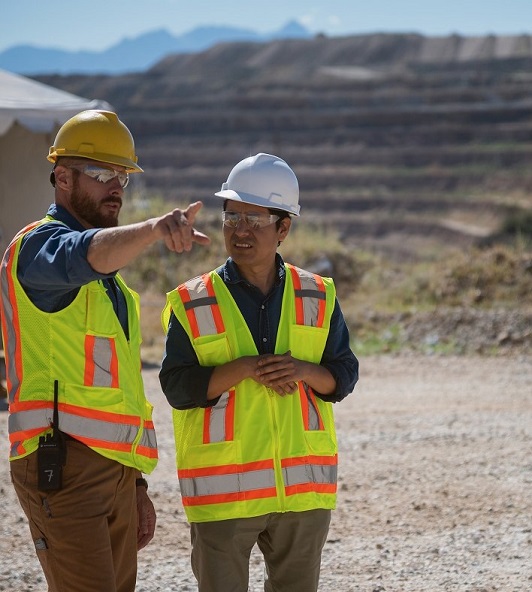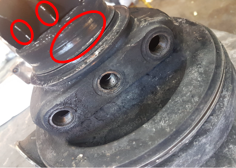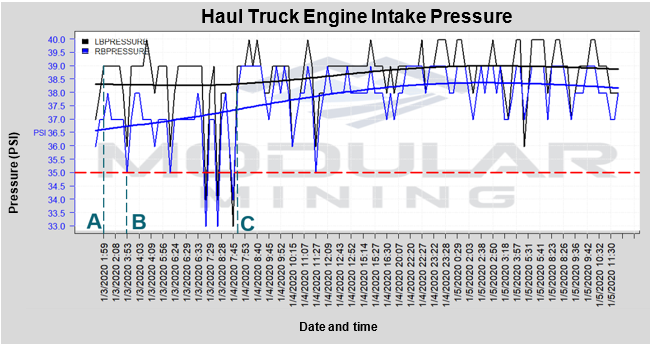Remote Component Monitoring Prevents Engine Failure and Downtime at Large Mine in Peru
Many sites rely on Original Equipment Manufacturer (OEM) sensors alone to notify them of problematic conditions affecting critical components in their equipment units. This reactive maintenance approach can delay notification alerts about preventable damage; by the time the default factory threshold settings that trigger many of these notifications have been met, the damage may have impacted other components.
LOCATION
Peru
OBJECTIVE
Identify component failures early to mitigate equipment damage
RESULTS
More than US$80,000 saved in prevented maintenance and downtime costs through early detection of turbocharger failure
This open-pit copper/zinc mine leverages Modular Mining’s MineCare® Maintenance Management system (in addition to the DISPATCH® FMS and ProVision® Machine Guidance systems), which enables them to approach equipment maintenance more proactively. The site also leverages Modular Mining’s RemoteCare™ service, which provides dedicated MineCare experts to remotely monitor the real-time condition of their equipment components. By focusing on component condition, rather than relying entirely on OEM sensors, the mine can identify emerging problems before significant damage or complete failure occurs.

Challenge
The RemoteCare team monitoring the equipment at the mine received an alert from the MineCare system about high differences in the intake pressures between the left and right banks in the engine of one of the mine’s haul trucks. Given the potential for serious engine damage if left unaddressed, as well as for costly downtime to both diagnose and replace the failing component, quickly identifying and resolving the root cause of the intake pressure difference was an immediate priority.
Solution
Together with the mine, RemoteCare personnel had previously established a custom, user-defined alert to monitor various component parameters, including intake pressures, on their equipment fleet. When the alert was triggered, the RemoteCare analyst started troubleshooting its possible cause and checking the real-time condition of other potentially-impacted components. After verifying the alert’s validity, the analyst immediately leveraged the data from the MineCare system to generate a report (figure 1) to assist the mine’s maintenance technicians while they performed a field inspection.
Upon inspection, the maintenance technician discovered that the truck’s right turbocharger was worn through. The technician sent the truck to the maintenance bay, where a new turbocharger was installed. The next day, the truck’s intake pressures resumed normal operation, and the truck was returned to the circuit.

Visible wear on the engine’s right turbocharger

Figure 1. The RemoteCare analyst leveraged data from the MineCare system to generate a report for the site’s maintenance technicians, which identified high differences in the pressures of the engine’s left and right banks, as indicated by the black and blue lines, respectively.
Legend:
A: MineCare identifies pressure difference; sends alert to RemoteCare analyst
B: Truck sent to maintenance bay for repair
C: Truck resumes normal operation
Results
By leveraging data from the MineCare system to identify the failing turbocharger early, the RemoteCare team helped the mine prevent damage to the truck’s engine injectors and other components. Replacing the failing turbocharger, rather than the 18 engine injectors that may have been compromised if the low intake pressure condition was left unaddressed, enabled the mine to save nearly $80,000 (US) in avoided injector replacement, labor, and additional downtime costs.
If the mine had relied on the truck’s OEM sensor alone to identify the failing turbocharger, its deterioration would have progressed to the point of extensive engine damage, incurring significantly higher costs for repair and longer downtime.
The MineCare with RemoteCare Maintenance Advantage
Leveraging the MineCare system with RemoteCare can help your mine:
Detect equipment degradation early through user-defined and OEM alerts
Increase the ratio of planned to unplanned maintenance activity by scheduling more repairs based on condition and priority
Minimize technician diagnosis time and safety risk via remote diagnostic information and complete workflow tasks. Remote technicians equates to fewer people at risk in the field.
Identify and correct undesirable equipment operating practices that can cause premature damage to equipment frames and other components
Make informed maintenance decisions based on reliable, real-time data and comprehensive reports

